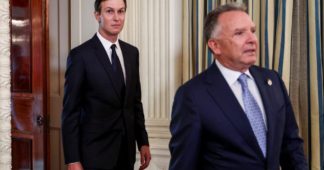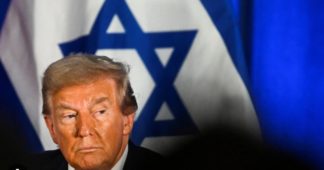US President Donald Trump welcomed the statement and demanded that Israel ‘immediately’ stop bombing Gaza
By Yasmine El-Sabawi in Washington
Oct 3, 2025
Hamas agreed to release all Israeli captives held in Gaza on Friday, after what it described as “in-depth consultations” with leadership ranks, Palestinian factions and mediators
The announcement comes just hours after US President Donald Trump warned on his TruthSocial account that Hamas should “RELEASE THE HOSTAGES, ALL OF THEM, INCLUDING THE BODIES OF THOSE THAT ARE DEAD, NOW! An Agreement must be reached with Hamas by Sunday Evening at SIX (6) P.M., Washington, D.C. time”.
It also comes five days after Trump announced his 20-point plan for Gaza alongside Israeli Prime Minister Benjamin Netanyahu.
“The movement announces its agreement to release all Israeli prisoners, both living and dead, according to the exchange formula contained in President Trump’s proposal, provided the field conditions for the exchange are met,” Hamas said in a statement.
“In this context, the movement affirms its readiness to immediately enter into negotiations through the mediators to discuss the details of this. The movement also renews its agreement to hand over the administration of the Gaza Strip to a Palestinian body of independents (technocrats), based on Palestinian national consensus and Arab and Islamic support,” the group added.
Trump, on his TruthSocial account, responded by demanding that Israel stop bombing Gaza immediately so the captives can be delivered safely.
“Based on the Statement just issued by Hamas, I believe they are ready for a lasting PEACE. Israel must immediately stop the bombing of Gaza, so that we can get the Hostages out safely and quickly!” Trump wrote.
“Right now, it’s far too dangerous to do that. We are already in discussions on details to be worked out. This is not about Gaza alone, this is about long sought PEACE in the Middle East,” he said.
Trump’s response took Israeli Prime Minister Benjamin Netanyahu by surprise, Washington correspondent for Israel’s Channel 12 Barak Ravid reported, quoting a senior Israeli official.
Points to negotiate
Hamas did not state that it agreed to the full 20-point plan as presented, and has, over the past week, repeatedly said that it needed to negotiate a number of points further.
Key among them is the demand for a demilitarised Gaza.
Hamas official Mousa Abu Marzouk told Al Jazeera that the group would not disarm before the Israeli occupation ends.
“The other issues mentioned in President Trump’s proposal regarding the future of the Gaza Strip and the inherent rights of the Palestinian people are linked to a comprehensive national position based on relevant international laws and resolutions, and are being discussed within a national framework,” the Hamas statement said.
A Hamas senior representative in Doha, Osama Hamdan, told Al Araby TV following the announcement that Hamas will not accept foreign governorship of the enclave, and that it must be run by Palestinians, even transitionally.
An overriding theme of the 20-point plan involves a Tony Blair-run team of billionaires and leading Zionist figures.
Trump also posted Hamas’s official statement on the matter to his TruthSocial account. This marks the first time a US president has presented to the American public the full wording of Hamas correspondence.
White House Press Secretary Karoline Leavitt has also shared a photo of Trump in the Oval Office, appearing to deliver remarks to a camera, saying that he is responding to Hamas’s “acceptance” of his “peace plan”.
Trump’s proposed plan
The 20-point plan proposed by Trump gave general precedence to Israel’s framing of the situation in Gaza and its stated security concerns, starting with point 1, which says “Gaza will be a deradicalised terror-free zone that does not pose a threat to its neighbours”.
The plan was widely criticised as “colonial thinking” for attempting to surrender the Palestinian people’s fate to foreign interests.
The plan proposed that Gaza would be redeveloped for the “benefit” of the people of Gaza “who have suffered more than enough”. Full aid would resume immediately after the acceptance of the agreement by all parties, but caveats the statement with “at a minimum, aid quantities will be consistent with what was included in the January 19, 2025, agreement”.
It adds that the Rafah crossing would also be opened in both directions, in line with the same mechanism as outlined in the January agreement.
The more pertinent point in the agreement is that it would effectively end the role of the controversial, scandal-ridden Gaza Humanitarian Foundation and give the responsibility to distribute aid to the United Nations and its agencies, as well as the Red Crescent and other international institutions “not associated in any manner with either party”.
The plan then pivots to post-war Gaza and a “Board of Peace” that would have oversight of the temporary transitional technocratic government in place. Hamas agreed to a transitional government, but one that arises from a Palestinian consensus. It has outrightly rejected foreign governorship of Gaza and disarming before the occupation ends.
The plan then touts a “Trump economic development plan” to revitalise Gaza, which has many parallels with the Gaza “Riviera” plan that Trump had initially proposed.
But unlike that initial plan, it states that “no one will be forced to leave Gaza” and if anyone does, they would be free to return.
The plan envisions an “International Stabilization Force” (ISF) that would be set up in tandem with “Arab and international partners” that is in charge of establishing control and stability in the enclave, similar to earlier plans discussed of an Arab or regional “peacekeeping” force.
The plan categorically states that “Israel will not occupy or annex Gaza”, but it leaves the window open for a lot of interpretation and puts the ball in Israel’s court to withdraw from the strip. It says that Israel will withdraw troops based on “standards, milestones and timeframes linked to demilitarisation” that Israeli forces, the ISF, guarantors and the US agree to.
It adds that Israeli forces would “progressively hand over the territory it occupies” to the ISF according to an agreement with the transitional government, “save for a security perimeter presence that will remain until Gaza is properly secure from any resurgent terror threat”.
Trump made it a point to highlight that, during their meeting, Netanyahu was firmly opposed to the establishment of a Palestinian state.
Point 18 in the released plan outlines that after Gaza’s redevelopment and the Palestinian Authority is reformed, “the conditions may finally be in place for a credible pathway to Palestinian self-determination and statehood, which we recognise as the aspiration of the Palestinian people”.
We remind our readers that publication of articles on our site does not mean that we agree with what is written. Our policy is to publish anything which we consider of interest, so as to assist our readers in forming their opinions. Sometimes we even publish articles with which we totally disagree, since we believe it is important for our readers to be informed on as wide a spectrum of views as possible.











